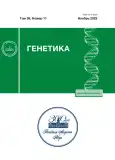Description of Divergence of Subpopulations in the Hierarchical System under the Analysis of Isonymy. II. Probabilities of Non-Isonymic Encounters
- Authors: Passekov V.P.1
-
Affiliations:
- Federal Research Center “Computer Science and Control” of Russian Academy of Sciences
- Issue: Vol 59, No 11 (2023)
- Pages: 1326-1340
- Section: МАТЕМАТИЧЕСКИЕ МОДЕЛИ И МЕТОДЫ
- URL: https://journals.rcsi.science/0016-6758/article/view/148185
- DOI: https://doi.org/10.31857/S0016675823110097
- EDN: https://elibrary.ru/TNBXXK
- ID: 148185
Cite item
Full Text
Abstract
Metapopulations with typical for human populations hierarchical subdivision into parts (subpopulations) are considered, corresponding to classifications based on administrative-territorial division (say, village, village council, district, region, and so on) or on a genealogical approach based on ethnogenesis, as well as on other principles of biological classification. The purpose of this work is to analyze the general properties of the distribution of the surname concentration over subpopulations in their hierarchical structure. Attention is focused on the description of the surname divergence of subpopulations, as an indicator of which the total probability of two person with different surnames encounter is considered, which is understood as the probability of the encounter in a randomly chosen subpopulation, a unit of observation, from metapopulation with a hierarchical structure. Its decomposition by hierarchy levels is obtained, which generalizes the Wahlund effect in population genetics. The total probability of non-isonimic encounters in a hierarchically subdivided metapopulation is less than the probability of random encounters in it by the sum of the average surname concentration intragroup variances corresponding to separate levels. Such properties are purely statistical characteristics of the hierarchical structure, and not a feature of a particular population system, and are not derived from the regularities of one or another model of microevolution. They are computationally formulated in the same way for any hierarchical system, although in the general case they do not coincide quantitatively. The results obtained refer to rural and urban hierarchical metapopulations as separate components of the entire population.
About the authors
V. P. Passekov
Federal Research Center “Computer Science and Control” of Russian Academy of Sciences
Author for correspondence.
Email: pass40@mail.ru
Russia, 119991, Moscow
References
- Ли Ч. Введение в популяционную генетику. М.: Мир, 1978. 555 с.
- Пасеков В.П. К анализу случайных процессов изонимии. I. Структура изонимии // Генетика. 2021. Т. 57. № 10. С. 1194–1204. https://doi.org/10.31857/S001667582110009X
- Пасеков В.П. К анализу случайных процессов изонимии. II. Динамика дивергенции популяций // Генетика. 2021. Т 57. № 11. С. 1318–1329. https://doi.org/10.31857/S0016675821110114
- Пасеков В.П. Описание дивергенции субпопуляций в иерархической системе при анализе изонимии. I. Дисперсия как показатель дивергенции // Генетика. 2022. Т. 58. № 6. С. 713–727.
- Wright S. The interpretation of population structure by F statistics with special regard to systems of mating // Evolution. 1965. V. 19. P. 395–420.
- Гинтер Е.К., Зинченко P.A., Ельчинова Г.И. и др. Роль факторов популяционной динамики в распространении наследственной патологии в российских популяциях // Мед. генетика. 2004. Т. 3. № 12. С. 548–555.
- Ревазов А.А., Парадеева Г.М., Русакова Г.И. Пригодность русских фамилий в качестве квазигенетического маркера // Генетика. 1986. Т. 22. № 4. С. 699–703.
- Crow J.F., Mange A.P. Measurement of inbreeding from the frequency of marriages between persons of the same surname // Social Biology. 1982. V. 29. № 1/2. P. 101–105.
- Lasker W.G. Surnames and Genetic Structure. Cambridge: Cambr. Univ. Press, 1985. 148 p.
- Сорокина И.Н., Чурносов М.И., Балтуцкая И.В. и др. Антропогенетическое изучение населения центральной России. М.: Изд-во РАМН, 2014. 336 с.
Supplementary files










